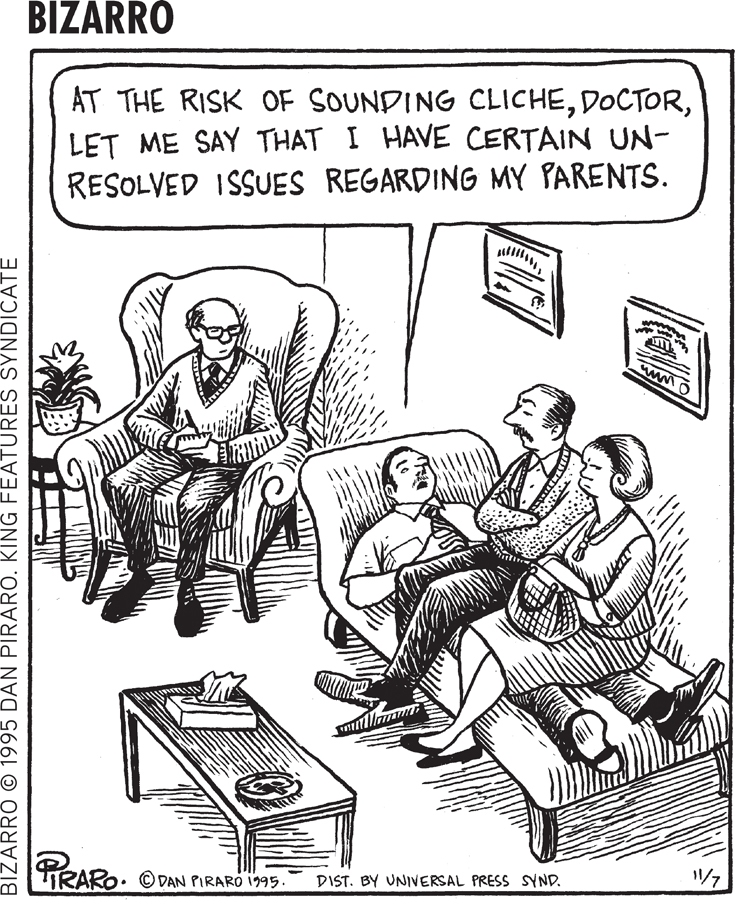15.2 Psychoanalytic Therapy
KEY THEME
Psychoanalysis is a form of therapy developed by Sigmund Freud and is based on his theory of personality.
KEY QUESTIONS
What are the key assumptions and techniques of psychoanalytic therapy?
How do short-term dynamic therapies differ from psychoanalysis, and what is interpersonal therapy?
When cartoonists portray a psychotherapy session, they often draw a person lying on a couch and talking while a bearded gentleman sits behind the patient, passively listening. This stereotype reflects some of the key ingredients of traditional psychoanalysis, a form of psychotherapy originally developed by Sigmund Freud in the early 1900s. Although psychoanalysis was developed a century ago, its assumptions and techniques continue to influence many psychotherapies today (Borden, 2009; Lerner, 2008; Luborsky & Barrett, 2006).
psychoanalysis (in psychotherapy)
A type of psychotherapy originated by Sigmund Freud in which free association, dream interpretation, and analysis of resistance and transference are used to explore repressed or unconscious impulses, anxieties, and internal conflicts.
Sigmund Freud and Psychoanalysis
As a therapy, traditional psychoanalysis is closely interwoven with Freud’s theory of personality. As you may recall from Chapter 11, on personality, Freud stressed that early childhood experiences provided the foundation for later personality development. When early experiences result in unresolved conflicts and frustrated urges, these emotionally charged memories are repressed, or pushed out of conscious awareness. Although unconscious, these repressed conflicts continue to influence a person’s thoughts and behavior, including the dynamics of his relationships with others.

Psychoanalysis is designed to help unearth unconscious conflicts so the patient attains insight as to the real source of her problems. Through the intense relationship that develops between the psychoanalyst and the patient, long-standing psychological conflicts are recognized and re-experienced. If the analytic treatment is successful, the conflicts are resolved.
Freud developed several techniques to coax long-repressed memories, impulses, and conflicts to a patient’s consciousness (Liff, 1992). In the famous technique called free association, the patient spontaneously reports all her thoughts, mental images, and feelings while lying on a couch. The psychoanalyst usually sits out of view, occasionally asking questions to encourage the flow of associations.
free association
A psychoanalytic technique in which the patient spontaneously reports all thoughts, feelings, and mental images that arise, revealing unconscious thoughts and emotions.
Blocks in free association, such as a sudden silence or an abrupt change of topic, were thought to be signs of resistance. Resistance is the patient’s conscious or unconscious attempts to block the process of revealing repressed memories and conflicts (Luborsky & Barrett, 2006). Resistance is a sign that the patient is uncomfortably close to uncovering psychologically threatening material.
resistance
In psychoanalysis, the patient’s unconscious attempts to block the revelation of repressed memories and conflicts.
Dream interpretation is another important psychoanalytic technique. Because psychological defenses are reduced during sleep, Freud (1911) believed that unconscious conflicts and repressed impulses were expressed symbolically in dream images. For example, Freud (1900) suggested that a lion in a woman’s dream referred to her father who had a “beard which encircled his face like a Mane.” Often, the dream images were used to trigger free associations that might shed light on the dream’s symbolic meaning.
dream interpretation
A technique used in psychoanalysis in which the content of dreams is analyzed for disguised or symbolic wishes, meanings, and motivations.
The resistance accompanies the treatment step by step. Every single association, every act of the person under treatment must reckon with the resistance and represents a compromise between the forces that are striving towards recovery and opposing ones.
—Sigmund Freud (1912)
More directly, the psychoanalyst sometimes makes carefully timed interpretations, explanations of the unconscious meaning of the patient’s behavior, thoughts, feelings, or dreams. The timing of such interpretations is important. If an interpretation is offered before the patient is psychologically ready to confront an issue, she may reject the interpretation or respond defensively, increasing resistance (Prochaska & Norcross, 2014).
interpretation
A technique used in psychoanalysis in which the psychoanalyst offers a carefully timed explanation of the patient’s dreams, free associations, or behaviors to facilitate the recognition of unconscious conflicts or motivations.

One of the most important processes that occurs in the relationship between the patient and the psychoanalyst is called transference. Transference occurs when the patient unconsciously responds to the therapist as though the therapist were a significant person in the patient’s life, often a parent. The psychoanalyst encourages transference by purposely remaining as neutral as possible. In other words, the psychoanalyst does not reveal personal feelings, take sides, make judgments, or actively advise the patient. This therapeutic neutrality is designed to produce “optimal frustration” so that the patient transfers and projects unresolved conflicts onto the psychoanalyst (Magnavita, 2008). These conflicts are then relived and played out in the context of the relationship between the psychoanalyst and the patient.
transference
In psychoanalysis, the process by which emotions and desires originally associated with a significant person in the patient’s life, such as a parent, are unconsciously transferred onto the psychoanalyst.
All of these psychoanalytic techniques are designed to help the patient see how past conflicts influence her current behavior and relationships, including her relationship with the psychoanalyst. Once these kinds of insights are achieved, the psychoanalyst helps the patient work through and resolve long-standing conflicts. As resolutions occur, maladaptive behavior patterns that were previously driven by unconscious conflicts can be replaced with more adaptive emotional and behavioral responses.
The intensive relationship between the patient and the psychoanalyst takes time to develop. The traditional psychoanalyst sees the patient three times a week or more, often for years (Schwartz, 2003; Zusman & others, 2007). Freud’s patients were on the couch six days a week (Liff, 1992). Obviously, traditional psychoanalysis is a slow, expensive process that few people can afford. For those who have the time and the money, traditional psychoanalysis is still available.
Short-Term Dynamic Therapies
Most people entering psychotherapy today are not seeking the kind of major personality overhaul that traditional psychoanalysis is designed to produce. Instead, people come to therapy expecting help with specific problems. People also expect therapy to provide beneficial changes in a matter of weeks or months, not years.
Many different forms of short-term dynamic therapies based on traditional psychoanalytic notions are now available (Levenson, 2010, 2011). These short-term dynamic therapies have several features in common. Therapeutic contact lasts for no more than a few months. The patient’s problems are quickly assessed at the beginning of therapy. The therapist and patient agree on specific, concrete, and attainable goals. In the actual sessions, most psychodynamic therapists are more directive than are traditional psychoanalysts, actively engaging the patient in a dialogue.
short-term dynamic therapies
Type of psychotherapy that is based on psychoanalytic theory but differs in that it is typically time-limited, has specific goals, and involves an active, rather than neutral, role for the therapist.
As in traditional psychoanalysis, the therapist uses interpretations to help the patient recognize hidden feelings and transferences that may be occurring in important relationships in her life (Kush, 2009).
One particularly influential short-term psychodynamic therapy is interpersonal therapy, abbreviated IPT. In contrast to other psychodynamic therapies, interpersonal therapy focuses on current relationships and social interactions rather than on past relationships. Originally developed as a brief treatment for major depressive disorder, interpersonal therapy is based on the assumption that psychological symptoms are caused and maintained by interpersonal problems (Gunlicks-Stoessel & Weissman, 2011).
interpersonal therapy (IPT)
A brief psychodynamic psychotherapy that focuses on current relationships and is based on the assumption that symptoms are caused and maintained by interpersonal problems.

Interpersonal therapy may be brief or long-term, but it is highly structured (Blanco & others, 2006; Teyber, 2009). In the first phase of treatment, the therapist identifies the interpersonal problem that is causing difficulties. In the interpersonal therapy model, there are four categories of personal problems: unresolved grief, role disputes, role transitions, and interpersonal deficits. Unresolved grief refers to problems dealing with the death of significant others, while role disputes refer to repetitive conflicts with significant others, such as the person’s partner, family members, friends, or co-workers. Role transitions include problems involving major life changes, such as going away to college, becoming a parent, getting married or divorced, or retiring. Interpersonal deficits refer to absent or faulty social skills that limit the ability to start or maintain healthy relationships with others (Mallinckrodt, 2001). During treatment, the therapist helps the person understand his particular interpersonal problem and develop strategies to resolve it.
IPT is used to treat eating disorders and substance use disorders as well as major depressive disorder. It is also effective in helping people deal with interpersonal problems, such as marital conflict, parenting issues, and conflicts at work (Bleiberg & Markowitz, 2008). In one innovative application, IPT was successfully used to treat symptoms of major depressive disorder in villagers in Uganda, demonstrating its effectiveness in a non-Western culture (Bolton & others, 2003). Beyond individual psychotherapy, IPT has proved to be valuable in family and group therapy sessions (Woody, 2008; Zimmerman, 2008).
Even though traditional, lengthy psychoanalysis is uncommon today, Freud’s basic assumptions and techniques continue to be influential. Contemporary research has challenged many of Freud’s original ideas. However, modern researchers continue to study the specific factors that seem to influence the effectiveness of basic Freudian techniques, such as dream analysis, interpretation, transference, and the role of insight in reducing psychological symptoms (Glucksman & Kramer, 2004; Luborsky & Barrett, 2006).